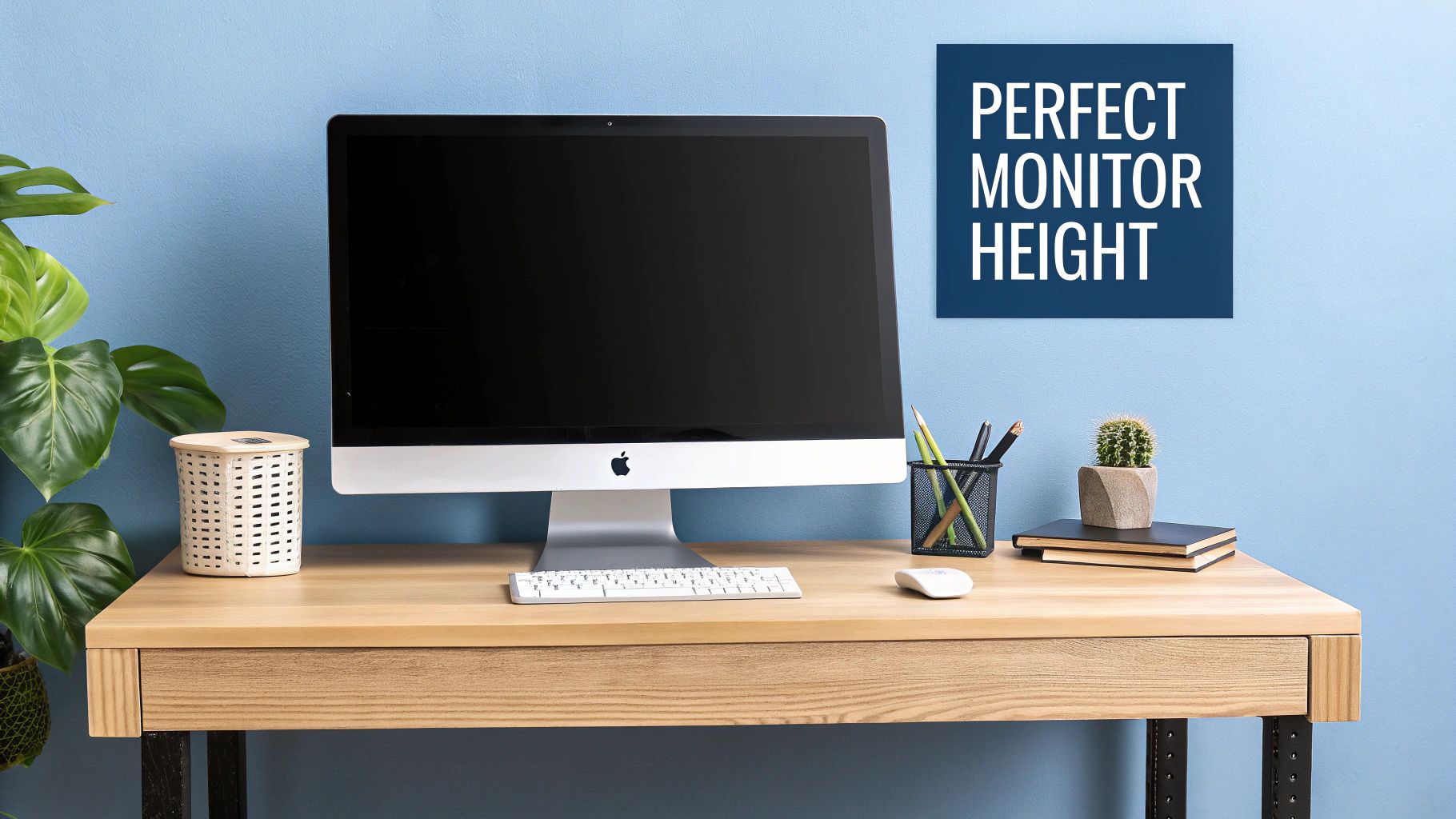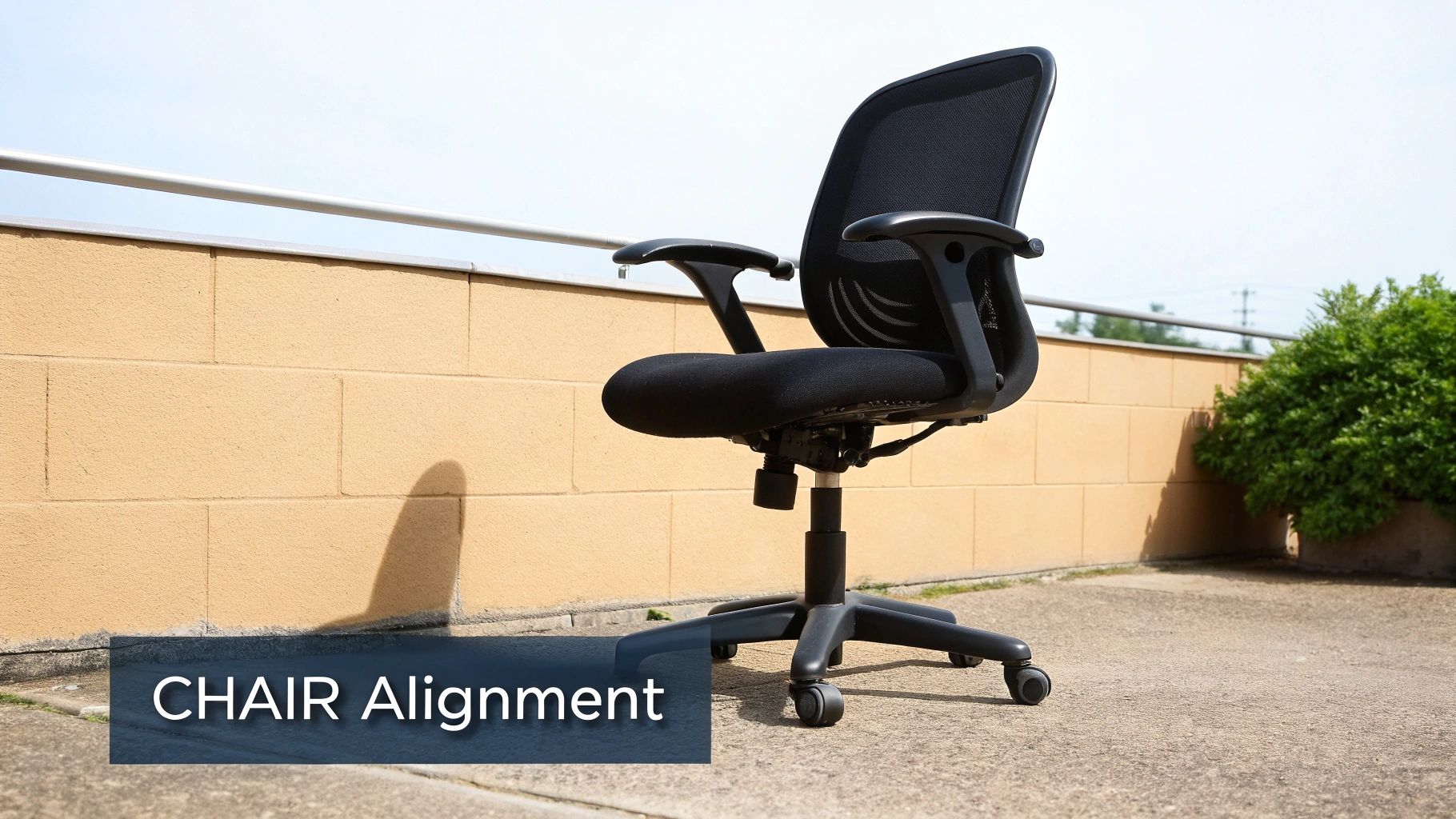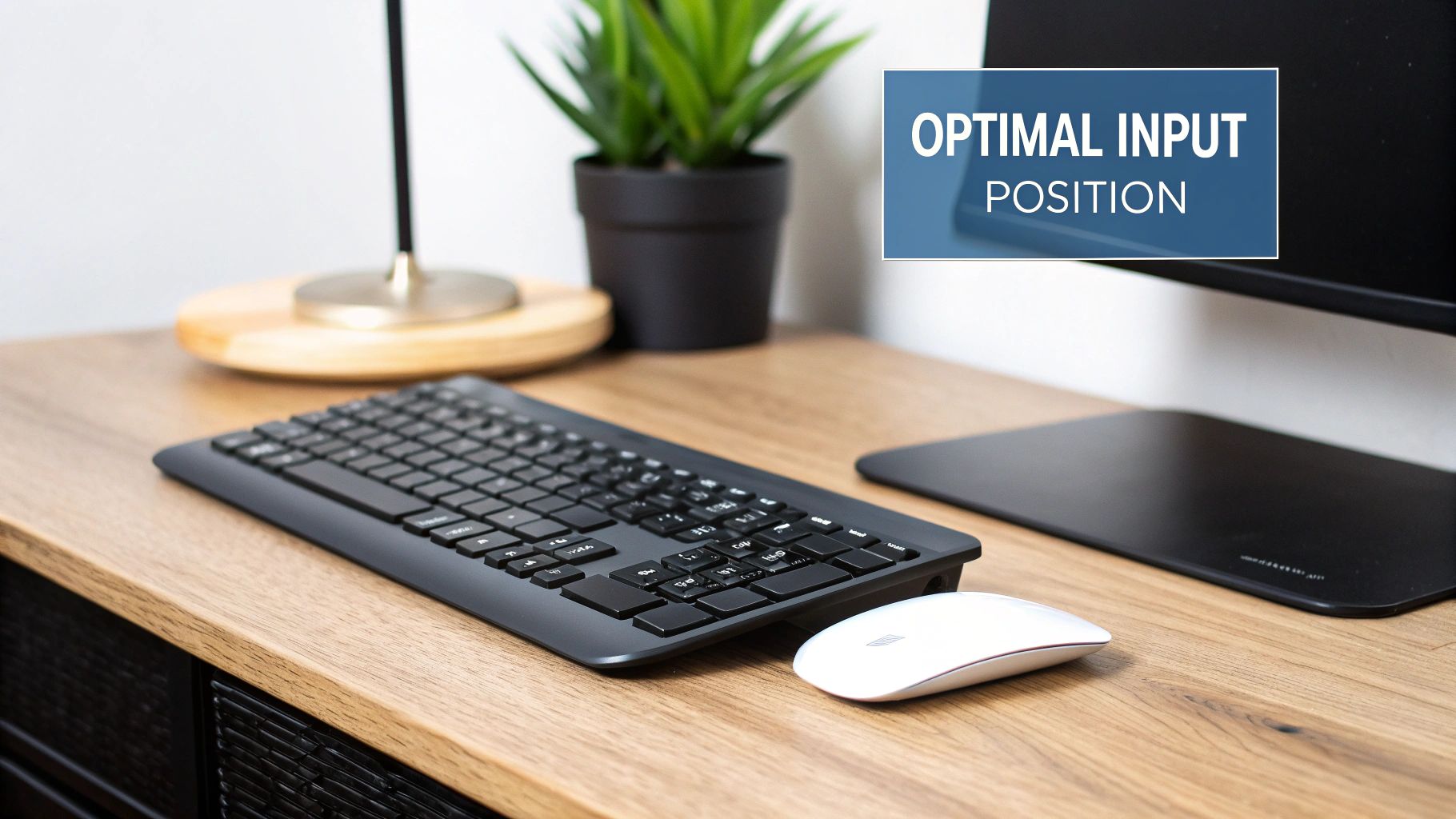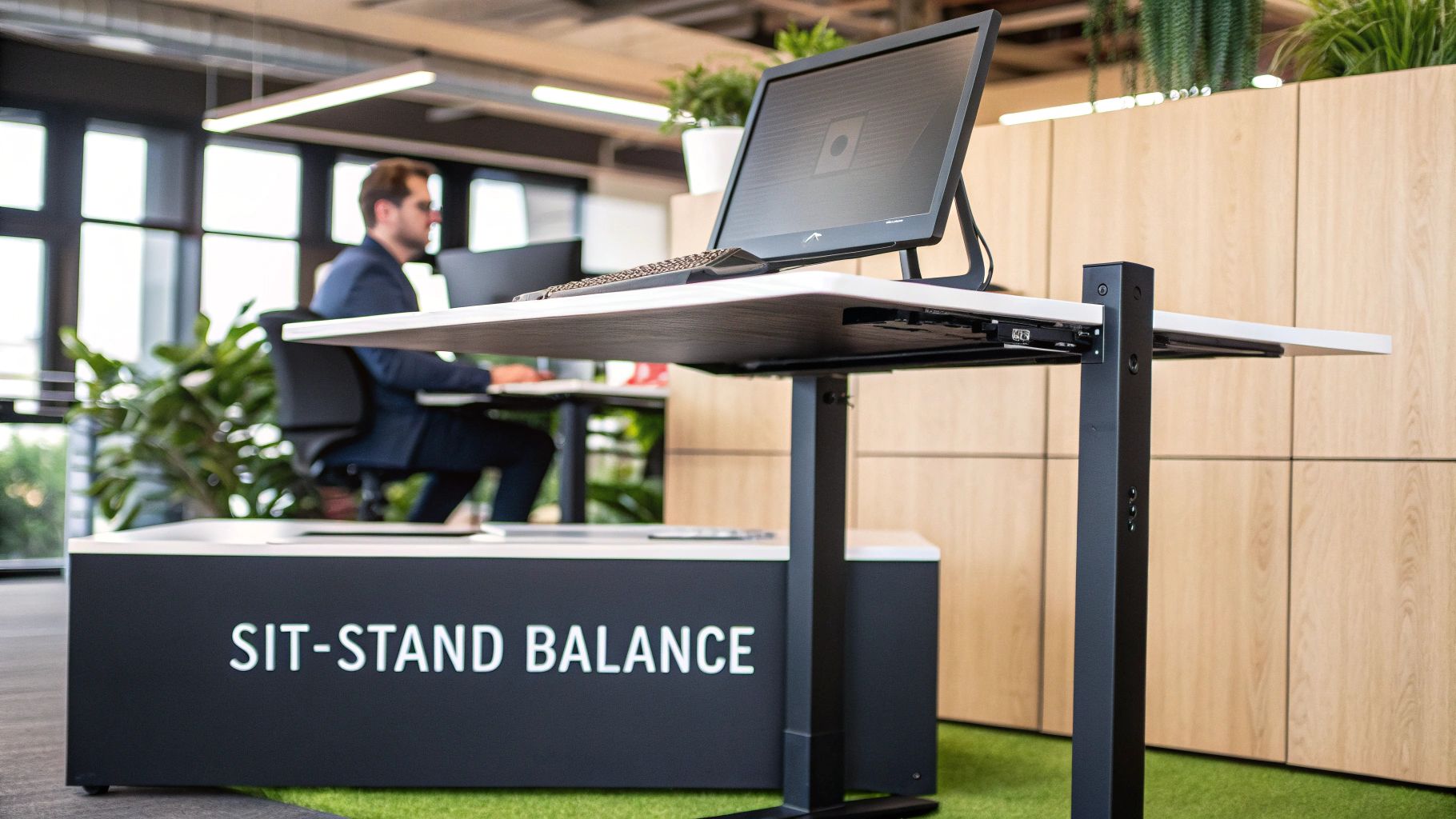The hours spent at a desk can take a significant toll on our bodies, leading to chronic back pain, neck strain, and decreased productivity. Slouching over a keyboard has become the default for many, but it doesn't have to be. Correcting your alignment isn't just about sitting up straight; it's a holistic approach that involves your entire workspace, from your monitor's height to the chair you sit in.
This guide will walk you through eight fundamental, science-backed strategies to transform your workstation into an ergonomic haven. We'll move beyond generic advice and provide specific, step-by-step instructions for optimizing every component of your setup. By implementing these practical ways to improve posture at desk, you can reclaim your comfort, enhance your focus, and build a foundation for long-term spinal health.
While optimizing your desk setup is crucial, broader strategies for maintaining good posture throughout your day can further enhance spinal health. For more general advice, you can find a wealth of actionable tips on how to maintain good posture and stop slouching that complement the workstation-specific techniques we cover here. For a comprehensive look at our ergonomic solutions, explore our main collection of workspace accessories.
1. Monitor Height and Distance Optimization
One of the most impactful ways to improve posture at your desk involves positioning your monitor correctly. Proper monitor placement is foundational to ergonomics, as it directly influences the alignment of your head, neck, and spine. When a screen is too low, you naturally crane your neck downwards; when it's too high or too far, you may jut your chin forward. Both of these habits lead to a condition known as "forward head posture," which places significant strain on your cervical spine and upper back muscles.

The goal is to achieve a neutral posture where your head is balanced directly over your shoulders. This principle is heavily endorsed by leading ergonomic research from organizations like OSHA and experts such as Cornell University's Dr. Alan Hedge. Tech giants like Google and Microsoft even standardize their office setups with adjustable monitor arms to ensure employees can easily achieve this optimal alignment, recognizing its direct impact on health and productivity.
How to Achieve Optimal Placement
To find the right position for your monitor, follow these simple yet effective guidelines:
- Height Adjustment: Sit back in your chair with a straight spine and look forward. The very top edge of your monitor's screen should be at or just slightly below your natural eye level. This encourages your eyes to look slightly downward, which is a more relaxed position for your eyelids.
- Distance Check: Position the monitor about an arm's length away, typically between 20-26 inches from your eyes. This distance prevents you from leaning forward to read text and reduces eye strain. If text appears too small, increase the font size in your system settings rather than moving closer.
Pro-Tip: A quick test for correct positioning is to close your eyes for a moment while sitting comfortably. When you open them, your gaze should land naturally on the top third of your screen.
Practical Tips for Any Setup
You don't need expensive equipment to get started. Use a stack of sturdy books or a dedicated monitor riser to elevate your screen. For laptop users, a laptop stand combined with an external keyboard and mouse is essential to separate the screen from the keyboard, allowing for proper height adjustment. For more advanced setups, you can explore the full collection of ergonomic monitor mounts to find the perfect solution for your workspace. If you want to dive deeper into the specifics, this ergonomic monitor placement guide for maximum productivity offers an excellent overview.
2. Chair Adjustment and Support Optimization
Your office chair is the foundation of a healthy posture, and its correct adjustment is critical. Proper chair setup supports the natural S-curve of your spine, preventing slouching and reducing the strain on your lower back. When your chair is misaligned, your entire musculoskeletal system compensates, leading to discomfort, fatigue, and long-term postural issues. Optimizing your seating is a fundamental step in creating an ergonomic workspace.

The goal is to create a stable base that encourages proper spinal alignment. This principle is championed by pioneers like Herman Miller and spine biomechanics expert Dr. Stuart McGill, who have demonstrated the link between dynamic seating and spinal health. Leading companies from Silicon Valley to Japanese corporate environments standardize their offices with chairs from brands like Herman Miller, Steelcase, and Okamura, recognizing that proper support directly enhances employee well-being and focus.
How to Achieve Optimal Placement
To configure your chair for maximum ergonomic benefit, focus on these key adjustments:
- Seat Height: Adjust the height so your feet rest flat on the floor and your knees are at a 90-degree angle, with your thighs parallel to the ground. This stabilizes your pelvis and supports your lower back.
- Lumbar Support: Position the lumbar curve of the chair to fit snugly into the small of your back. This support is crucial for maintaining the natural inward curve (lordosis) of your lower spine and preventing slouching.
- Seat Depth: Sit back fully in the chair. There should be a gap of about two to three fingers' width between the back of your knees and the edge of the seat. This prevents pressure on the nerves and blood vessels behind your knees.
Pro-Tip: If your chair lacks built-in lumbar support, roll up a small towel or use a dedicated lumbar pillow and place it in the curve of your lower back for immediate improvement.
Practical Tips for Any Setup
You can improve your seating without buying a new chair. First, ensure your armrests are positioned so your shoulders are relaxed and your forearms are parallel to the floor. If your feet don't reach the floor comfortably after adjusting the height, use a footrest. For those considering an upgrade, explore an extensive collection of ergonomic chairs to find a model with the adjustability you need. Investing in a properly configured chair is one of the most effective ways to improve posture at your desk for years to come.
3. Keyboard and Mouse Positioning
Improving your posture at a desk extends beyond just your chair and monitor; the placement of your keyboard and mouse is crucial for maintaining upper body alignment. Incorrect positioning forces you to elevate your shoulders, bend your wrists awkwardly, or constantly reach, leading to tension in the shoulders, forearms, and wrists. These subtle but constant strains can contribute to repetitive strain injuries (RSIs) like carpal tunnel syndrome and disrupt your entire postural chain.

The goal is to create a setup where your arms can rest in a relaxed, neutral state. This principle has been championed by pioneers in ergonomic design, from IBM's early keyboard research to the development of Microsoft's and Logitech's popular ergonomic peripherals. These companies invested heavily in understanding how input devices affect the user's body, proving that proper positioning is a key factor in long-term comfort and one of the most effective ways to improve posture at desk.
How to Achieve Optimal Placement
To arrange your keyboard and mouse for better posture, focus on creating a natural and relaxed arm position. Follow these specific guidelines:
- Elbow Angle: Position your keyboard at a height that allows your elbows to be bent at an approximate 90-degree angle, with your forearms parallel to the floor. Your shoulders should be relaxed, not hunched up towards your ears.
- Wrist Alignment: Your wrists should be in a straight, neutral position, not bent up, down, or to the sides. Avoid resting your wrists on the sharp edge of the desk.
- Mouse Proximity: Place your mouse on the same level as your keyboard and as close to it as possible. This minimizes reaching and twisting, allowing your arm to move as a single unit from the elbow, not just the wrist.
Pro-Tip: Your hands should be able to float over the keyboard as you type, with your fingers gently curved. If your desk is too high to achieve the correct elbow angle, an under-desk keyboard tray is an excellent solution.
Practical Tips for Any Setup
You can immediately improve your setup with a few simple adjustments. If your desk is too high, use an adjustable keyboard tray to bring your devices to the correct level. Consider split or curved ergonomic keyboards, which promote a more natural hand and wrist posture. For a deeper understanding of how accessories can help, this guide on keyboard wrist rest ergonomics offers valuable insights. To further enhance your workspace, explore our complete collection of ergonomic keyboard and mouse solutions to find the perfect fit for your needs.
4. Frequent Movement and Position Changes
One of the most crucial ways to improve posture at your desk is to understand that the best posture is your next posture. The human body is designed for movement, not for remaining in a static position for hours. Prolonged sitting, even in an ergonomically correct chair, can lead to muscle fatigue, reduced circulation, and significant strain on your spine. Embracing the concept of dynamic posture means regularly shifting your position to prevent these negative effects.

This principle is at the core of modern workplace wellness and is championed by experts like Dr. James Levine, a Mayo Clinic researcher who coined the term "sitting is the new smoking." Tech companies have integrated this philosophy into their products; for instance, the Apple Watch's "Stand" reminders and Fitbit's "Reminders to Move" are designed to combat sedentary behavior. By frequently changing positions, you activate different muscle groups, promote blood flow, and give overworked muscles a chance to recover.
How to Integrate More Movement
Incorporating regular movement into your workday doesn't require a major overhaul of your routine. The key is to build small, consistent habits:
- Set Timers: Use a phone or desktop app to set a reminder every 30-60 minutes. When it goes off, stand up, stretch, walk to get water, or simply adjust your sitting position.
- Embrace "Active" Tasks: Turn passive tasks into active ones. Take phone calls while standing or walking around. Instead of sending an instant message to a colleague, walk over to their desk.
- Utilize Sit-Stand Desks: If you have an adjustable desk, alternate between sitting and standing throughout the day. A common pattern is 20 minutes sitting, 8 minutes standing, and 2 minutes of gentle movement.
Pro-Tip: Make your breaks count. Instead of scrolling on your phone, use your bathroom breaks or coffee runs as opportunities for a quick walk or a few deep stretches to reset your posture.
Practical Tips for Any Setup
Even in a fixed-desk environment, you can foster a more dynamic workday. Simple desk-based stretches, such as neck rolls, shoulder shrugs, and spinal twists, can be performed while seated. The goal is to avoid locking your body into one position for too long. For those looking to upgrade their workspace to better facilitate movement, exploring a complete collection of ergonomic office accessories can provide solutions like sit-stand desk converters and active seating options. For more ideas on creating a movement-friendly space, this guide on dynamic workstations offers excellent insights.
5. Standing Desk Implementation
Introducing a standing desk or a sit-stand converter is a dynamic strategy for improving posture at your desk. These workstations allow you to alternate between sitting and standing, which disrupts the static, sedentary posture that contributes to lower back pain, weakened core muscles, and poor spinal alignment. The core benefit isn't standing all day, but rather the regular movement and postural variation it encourages.
This approach prevents the muscle fatigue and spinal compression that builds up from hours of uninterrupted sitting. The practice has been widely adopted by forward-thinking organizations, with tech leaders like Meta standardizing sit-stand workstations and even BBC News anchors using them on-air to maintain energy and presence. Research from experts like Dr. Alan Hedge at Cornell University has highlighted how alternating positions can significantly reduce musculoskeletal discomfort, making it a cornerstone of modern office ergonomics.
How to Achieve Optimal Implementation
The goal is to integrate standing into your routine gradually, not replace sitting entirely. This balance is key to reaping the benefits without causing new strains.
- Alternate Regularly: Start by standing for 15-30 minutes for every hour you sit. Use a timer to remind yourself to switch positions. This simple habit promotes blood flow and engages different muscle groups.
- Maintain Ergonomics: Apply the same ergonomic principles when standing. Your keyboard and mouse should be at a height that allows your elbows to be bent at a 90-degree angle, and your monitor should be at eye level.
- Support Your Body: Use an anti-fatigue mat to cushion your feet and reduce strain on your legs and lower back. Wearing supportive, comfortable shoes is also crucial for preventing foot pain during standing periods.
Pro-Tip: Ease into it. Begin with short standing intervals of just 15 minutes, two or three times a day. Gradually increase the duration as your body adapts and your stamina improves.
Practical Tips for Any Setup
You can start without overhauling your entire office. A sit-stand desk converter is an excellent and affordable way to transform your existing desk into an ergonomic powerhouse. For those ready for a full upgrade, you can explore the entire collection of ergonomic sit-stand desks to find the perfect fit for your space and needs. To maximize the benefits and keep your muscles active while you stand, consider incorporating some simple movements, as detailed in this helpful guide on easy standing desk exercises.
6. Core Strengthening and Posture Awareness
While ergonomic equipment provides external support, one of the most effective ways to improve posture at your desk involves building your body's internal support system: your core. Strong abdominal and lower back muscles act like a natural corset for your spine, reducing the strain on your vertebrae and helping you maintain an upright position effortlessly. When your core is weak, you tend to slump and rely heavily on your chair for support, leading to poor alignment and discomfort.
This principle is a cornerstone of methodologies developed by figures like Joseph Pilates and spine biomechanics expert Dr. Stuart McGill. Their research emphasizes that true spinal stability comes from within. This is why physical therapy clinics often use Pilates for postural rehabilitation, and corporate wellness programs are increasingly incorporating desk-friendly core exercises. These practices shift the focus from passive support to active, conscious postural control.
How to Build Core Strength and Awareness
Integrating core work into your daily routine doesn't require hours at the gym. The key is consistency and combining strengthening with mindfulness.
- Practice Active Sitting: Instead of slouching back, sit at the edge of your chair for short periods and consciously engage your core muscles to hold your spine straight. Imagine a string pulling the crown of your head toward the ceiling.
- Incorporate Micro-Exercises: Perform simple movements throughout the day. Try abdominal bracing by gently tightening your stomach muscles as if preparing for a light punch, holding for 10-15 seconds. Seated leg lifts are another excellent, discreet option.
- Schedule Posture Checks: Set hourly reminders on your phone or computer to check in with your body. Are your shoulders relaxed? Is your back straight? This practice builds the habit of postural self-awareness.
Pro-Tip: Use your breath to engage your deep core. As you exhale, gently draw your belly button in towards your spine. This activates the transverse abdominis, a key stabilizing muscle.
Practical Tips for Any Setup
You can start strengthening your core right now, with no equipment needed. Make simple exercises like planks and bridges a part of your morning or evening routine to build foundational strength. For a more structured approach, many yoga studios now offer "desk warrior" classes specifically designed to counteract the effects of sitting. By actively strengthening your core, you are investing in a long-term solution for better posture, which is a critical component of a truly ergonomic workstation setup. For more ideas on integrating these habits, our complete guide to setting up an ergonomic workstation can provide additional context.
7. Proper Lighting and Glare Reduction
One of the most overlooked ways to improve posture at your desk is by managing your workspace lighting. Poor lighting or harsh screen glare forces you to compensate by leaning in, squinting, or adopting awkward positions just to see your screen clearly. This subtle but constant adjustment leads to forward head posture, neck strain, and upper back pain as your body works overtime to fight visual discomfort.
The core principle is to create a visually comfortable environment that doesn't force postural compromises. This is a key focus in ergonomic design, with standards set by organizations like the Illuminating Engineering Society (IES) and OSHA. Tech and creative giants like Pixar and Apple meticulously design their office lighting to reduce animator eye strain and boost focus, recognizing that a well-lit space directly supports physical well-being and productivity.
How to Achieve Optimal Lighting
To prevent your body from contorting to see better, focus on creating balanced, glare-free light with these guidelines:
- Eliminate Glare: Position your monitor perpendicular (at a 90-degree angle) to bright light sources like windows. Use blinds or curtains to control intense natural light throughout the day.
- Balance Brightness: Adjust your screen's brightness to match the ambient light level in your room. A screen that is much brighter or dimmer than its surroundings causes significant eye fatigue.
- Reduce Contrast: A dark room with a bright screen creates high contrast, which strains your eyes. Use a soft, ambient lamp in your workspace or consider bias lighting (a light strip behind your monitor) to reduce the stark difference.
Pro-Tip: To check for glare, turn off your monitor and look at the dark screen. If you can see clear reflections of windows, lights, or yourself, you have a glare problem that needs addressing.
Practical Tips for Any Setup
You can easily improve your lighting without a major overhaul. An anti-glare screen filter is an affordable solution to diffuse reflections on your monitor. For those dealing with overhead fluorescent lights, a simple desk lamp can provide focused, softer task lighting that you can control. For a comprehensive look at setting up your space, this guide to the best lighting for computer work offers excellent in-depth advice. Ultimately, a properly lit environment is a crucial component of a truly ergonomic workstation.
8. Document and Reference Material Positioning
Improving posture at your desk extends beyond your chair and screen; it involves everything you interact with. The positioning of frequently referenced documents, phones, and other materials is a critical, yet often overlooked, ergonomic factor. Constantly twisting your neck to view a document lying flat on your desk or reaching across your body for a phone forces repetitive, awkward movements. These micro-strains accumulate, leading to muscle imbalances, neck pain, and a gradual decline in posture.
The goal is to bring essential work materials into your primary functional zone, minimizing neck rotation and unnecessary reaching. This principle is heavily promoted by occupational therapists and ergonomic consultants who conduct workplace assessments. In high-volume environments like legal offices or accounting firms, organizing reference materials is not just about efficiency; it is a core strategy for preventing repetitive strain injuries and maintaining employee well-being throughout long hours.
How to Achieve Optimal Placement
To arrange your reference materials ergonomically, focus on minimizing movement and keeping your spine neutral:
- Align with Your Monitor: Place frequently used documents on a document holder positioned directly next to your monitor and at the same height and distance. This allows you to glance between the screen and the document with a simple eye movement rather than a full head and neck turn.
- Create Functional Zones: Keep your most-used items, like your phone, notepad, or stapler, within your primary work zone (easy arm's reach without leaning). Secondary items can be placed slightly further away. This organization strategy is key to preventing habitual over-reaching.
Pro-Tip: If you spend a significant amount of time on the phone, a headset is non-negotiable. Cradling a phone between your ear and shoulder is one of the quickest ways to create severe neck and shoulder strain.
Practical Tips for Any Setup
You can implement these changes immediately with little to no cost, making it one of the most accessible ways to improve posture at your desk.
- Use a Document Holder: An adjustable document holder is an inexpensive tool that pays huge dividends in neck and back comfort. Place it on your non-dominant side next to your screen.
- Go Digital When Possible: Convert physical documents to digital ones and use a split-screen view to reference them. This keeps all information in a single, ergonomically sound viewing plane.
- Leverage Desk Organizers: Use trays and vertical organizers to keep materials within reach without creating clutter. For a complete workstation overhaul, explore the full collection of ergonomic desk accessories to find solutions that fit your specific workflow.
8 Strategies for Improving Desk Posture Comparison
| Item | Implementation Complexity 🔄 | Resource Requirements ⚡ | Expected Outcomes 📊 | Ideal Use Cases 💡 | Key Advantages ⭐ |
|---|---|---|---|---|---|
| Monitor Height and Distance Optimization | Low to Medium 🔄 | Low to Medium ⚡ (monitor stand/arm) | Reduces neck/shoulder strain and eye fatigue 📊 | Office setups with desktop or external monitors 💡 | Improves spinal alignment; prevents forward head posture ⭐ |
| Chair Adjustment and Support Optimization | Medium 🔄 | Medium to High ⚡ (ergonomic chair) | Reduces lower back pain; supports spinal curve 📊 | Work environments requiring prolonged sitting 💡 | Decreases muscle fatigue; improves circulation ⭐ |
| Keyboard and Mouse Positioning | Medium 🔄 | Low to Medium ⚡ (keyboard tray, accessories) | Prevents repetitive strain injuries; improves comfort 📊 | Desk work with frequent typing and mouse use 💡 | Maintains upper body alignment; reduces tension ⭐ |
| Frequent Movement and Position Changes | Low to Medium 🔄 | Low ⚡ | Prevents stiffness and improves circulation 📊 | Sedentary jobs emphasizing health breaks 💡 | Maintains joint mobility; reduces DVT risk ⭐ |
| Standing Desk Implementation | Medium 🔄 | Medium to High ⚡ (adjustable desk, mats) | Reduces back pain; increases energy and posture awareness 📊 | Flexible office setups; employees desiring sit-stand options 💡 | Boosts productivity; reduces lower back pressure ⭐ |
| Core Strengthening and Posture Awareness | High 🔄 | Low ⚡ (exercise time, possible guidance) | Improves spinal health and internal support 📊 | Wellness programs; individuals seeking posture improvement 💡 | Enhances body awareness; reduces reliance on supports ⭐ |
| Proper Lighting and Glare Reduction | Low to Medium 🔄 | Low to Medium ⚡ (lighting accessories) | Reduces eye strain and awkward posture 📊 | Workspaces with variable natural/artificial lighting 💡 | Improves comfort and reduces muscle tension ⭐ |
| Document and Reference Material Positioning | Low 🔄 | Low ⚡ | Minimizes neck rotation and reaching strain 📊 | Jobs needing frequent document or phone reference 💡 | Improves workspace efficiency; reduces repetitive strain ⭐ |
Building Your Foundation for a Pain-Free Workday
You've now explored a comprehensive roadmap detailing effective ways to improve posture at desk, moving far beyond the simple advice to "sit up straight." The journey to a healthier, more comfortable workday is not about finding a single magic bullet. Instead, it’s about creating a holistic, supportive ecosystem where your body can thrive, even during long hours of focused work. This involves a dynamic interplay between your equipment, your environment, and your personal habits.
We've covered the foundational elements of ergonomic success, from the precise alignment of your monitor and the meticulous adjustment of your chair to the strategic placement of your keyboard and mouse. These initial setup steps are crucial, as they create the physical framework for good posture. However, a static perfect setup is not the end goal. True ergonomic wellness is dynamic.
From Passive Setup to Active Practice
The most significant takeaway is the shift from a passive mindset to an active one. Your workspace is not a fixed environment but a tool that should adapt to you throughout the day. This is why integrating frequent movement, utilizing a standing desk, and being mindful of your core engagement are just as critical as your initial equipment configuration. These practices transform your desk from a place of sedentary risk into a hub of productivity and physical well-being.
Remember, consistency is more valuable than perfection. The goal is to build sustainable habits that become second nature.
- Start Small: Don't feel pressured to implement all eight strategies at once. Choose one or two that seem most achievable, like adjusting your monitor height or setting a timer to stand up every 30 minutes.
- Listen to Your Body: Pay close attention to signals of discomfort. Aches in your neck, shoulders, or lower back are your body's way of telling you that an adjustment is needed.
- Iterate and Refine: Your ideal setup might change over time. Re-evaluate your workstation periodically and make small tweaks to ensure it continues to meet your needs.
Mastering these concepts is an investment in your long-term health, directly impacting your energy levels, focus, and overall quality of life. By consciously building a better relationship with your workspace, you are taking a powerful step toward preventing chronic pain and enhancing your professional performance. This foundation of ergonomic awareness will serve you for years to come, ensuring your work empowers you rather than drains you.
Ready to transform your workspace from a source of strain into a catalyst for success? Mount-It provides the ergonomic tools you need to implement these strategies, from fully adjustable monitor mounts and sit-stand desks to under-desk keyboard trays. Explore our complete collection of Mount-It solutions and build the supportive, dynamic workstation you deserve.

